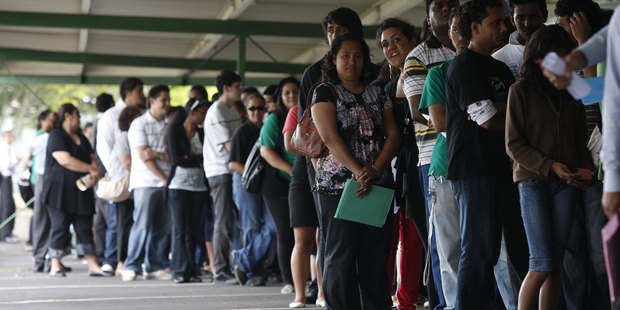The Aussie rally may have just started
Published on Senin, 10 Februari 2014
12.33 //
Market News,
news
The beleaguered Australian dollar,
last year's worst performing G10 currency, surged roughly 2 percent
last week reviving hopes for a comeback, analysts told CNBC.
The Aussie has been heading higher ever since the Reserve Bank of Australia (RBA) removed its easing bias at its first policy meeting of the year. It hit a four-week high of 0.8997 cents on Friday, after weaker-than-expected U.S. jobs data hurt the greenback, giving the Aussie a further boost.
"In the medium term we think we're going to be looking at some Aussie strength," said Chris Tedder, market strategist at Forex.com.
"We've just seen last week the RBA remove its easing bias and that takes away some of the possible Aussie downside," he added.
Australian unemployment data, due out on Thursday, will be closely watched by currency traders after December's huge jobs miss, when Australian employers sacked the most people in nine months, sending the Aussie tumbling to its lowest level since August 2010.
But this week's unemployment data could prompt a bounce for the Aussie, said Forex.com's Tedder.
"We are looking for a surprise on the upside in this week's unemployment data so we think that could lead [the Aussie] to move to 90 cents in the short term, and back up to around 92-93 cents in the medium term. That's [the Aussie] one of our favorite trades at the moment," he added.
But other analysts have warned that the
recent uptick in the currency could prove a false dawn, and that a
number of negative headwinds were still set to push the currency lower
this year. The Aussie has been heading higher ever since the Reserve Bank of Australia (RBA) removed its easing bias at its first policy meeting of the year. It hit a four-week high of 0.8997 cents on Friday, after weaker-than-expected U.S. jobs data hurt the greenback, giving the Aussie a further boost.
"In the medium term we think we're going to be looking at some Aussie strength," said Chris Tedder, market strategist at Forex.com.
"We've just seen last week the RBA remove its easing bias and that takes away some of the possible Aussie downside," he added.
Australian unemployment data, due out on Thursday, will be closely watched by currency traders after December's huge jobs miss, when Australian employers sacked the most people in nine months, sending the Aussie tumbling to its lowest level since August 2010.
But this week's unemployment data could prompt a bounce for the Aussie, said Forex.com's Tedder.
"We are looking for a surprise on the upside in this week's unemployment data so we think that could lead [the Aussie] to move to 90 cents in the short term, and back up to around 92-93 cents in the medium term. That's [the Aussie] one of our favorite trades at the moment," he added.
"The recent price action hasn't inspired much confidence," said Paul Mackel, head of Asian FX research at HSBC, referring to Monday's trading, where the Aussie had fallen slightly back to 0.8955 in Asia morning trade.
"We see it slowly drifting to 86 cents by the end of the year, partly because of China, but also because we are positive on the U.S. dollar this year," he said.
(Read More: Is the euro headedfor an Aussie-style crash?)
Mackel said investors should not get too relaxed about the RBA's more hawkish rhetoric recently as it could all change depending on data.
At its February meeting the central bank removed its easing bias, after eight interest rate cuts in two years, and toned down talk of wanting the currency lower.
"The language of the RBA is data dependent, so it's not inspiring a huge level of confidence. Yes, they are not as concerned as last year, but risks remain, from China from the possibility of a deterioration in the external environment," he added.
Timothy Riddell, head of global markets research at Australian investment bank ANZ, said though it was not the bank's core view, there was a risk that jobs data this week could spur a position covering and short-term bounce towards the 92-93 cents level. But he said the "squeeze" was likely to be short-lived, and the Aussie would eventually fall back to the mid-80s.
"There are still a lot of substantial headwinds for the Aussie and the path of least resistance is still to the downside," Riddell told CNBC, naming a firmer U.S. dollar, a slowdown in Asian growth in general and the large build up in China's resource stockpiles, as key negative drivers.
He also pointed to recent Commodities Futures Trading Commission data which showed that the Aussie dollar short trade, extremely popular last year, was still very much in play despite seeing a mild reduction.



















Did you know you can create short urls with Shortest and make dollars from every click on your short urls.
BalasHapusQuantum Binary Signals
BalasHapusProfessional trading signals delivered to your cell phone daily.
Start following our trades today and gain up to 270% a day.
GPS robot tripled the $100k deposit [live proof authenticated by myfxbook and broker]
BalasHapusI just finished a webinar with Mark and his partner, Antony, two days ago and it was GREAT.
During the webinar MARK and ANTONY shared their stories to success and answered questions about their new release of the GPS Forex Robot that CAME OUT TODAY!